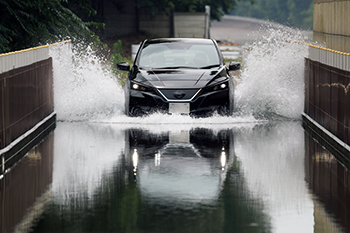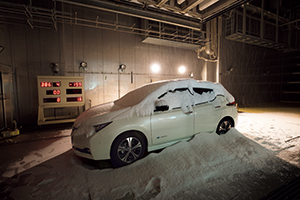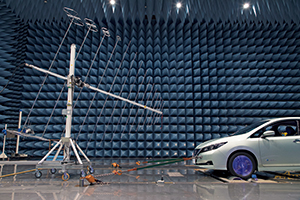Improving Initial Quality
Various environmental tests to eliminate customer’s concerns
Nissan is conducting various environmental tests from a customer-centric perspective using prototype vehicles in the final stage of development. Through these tests, we carefully check that there are no issues from all perspectives such as easy to use, driving and safety.
Waterway driving test
Electric vehicles have many electronic components installed such as motors and batteries. Many people still have concerns such as “If there is a flood, will it leak electricity?”, ”Can you get an electric shock while charging the car?”. We have conducted many tests to dispel those concerns, one of them is the waterway driving test. This is a test to drive a vehicle on a roadway through deep water to evaluate/confirm safety such as electric shocks or electric leakage. At the same time, we also conduct evaluations to prevent damage to each part of vehicle that could be caused by exposure to water. By verifying these conditions, we thoroughly analyze the test results and remove potential issues in advance.

High speed waterway driving test. By thoroughly evaluating and confirming the safety of electric shocks and electric leakage at the design phase, we are implementing measures to prevent it completely.
Snow cover test
A Nissan LEAF generates only approximately one tenth the heat of a gasoline-fueled vehicle, so if snow enters the hood area and freezes it can prevent proper operation. To check the performance under these conditions, at first we confirm that on the drawing snow cannot enter the hood area. Then later in development we conduct an overnight test on a prototype vehicle utilizing artificial snow generated in a laboratory to confirm that snow does not enter the hood area.

Radio waves test
In recent years radio wave technology and the use of this technology has increased, which can also impact certain vehicle systems. Radio wave tests are completed to check for interference with TV/radio broadcasting base stations as well as radio tower radars. These tests make sure vehicle systems operation are not impacted by these radio waves.

By conducting such validation tests, we ensure the quality for the customer's peace of mind.

